Benchmarking Asset Management Plans for Solar PV Power Plants
VerifiedAdded on 2023/06/09
|81
|19179
|81
Project
AI Summary
This project provides a comprehensive analysis of asset management plans for large-scale solar PV power plants in Australia. It begins with an abstract outlining the importance of strategic asset management in the context of growing environmental regulations and increasing energy demands. The study explores the existing gaps in asset management frameworks, particularly in the Australian solar energy sector, which lags behind other countries despite high solar radiation levels. The project aims to develop a best-practice strategic asset management framework for these plants, encompassing literature reviews on asset management, current practices, and best practices from around the world. The research methodology includes a detailed discussion of research philosophy, strategy, and data collection methods such as questionnaires, interviews, and secondary sources. The results and discussion section includes case studies and comparative analyses of different asset management plans, including the TasNetworks Strategic Asset Management Plan. The project culminates in conclusions and recommendations for improving asset management practices to optimize costs, performance, and risk management across the lifecycle of solar PV assets, ultimately enhancing the efficiency and sustainability of solar power generation in Australia.

benchmarking of asset
management plans for large solar
PV Power plants in australia
management plans for large solar
PV Power plants in australia
Paraphrase This Document
Need a fresh take? Get an instant paraphrase of this document with our AI Paraphraser

Abstract
The strict environmental regulation besides the higher demands for energy owing to the ever
rapidly increasing human population in Australia and the world at large have turned out to be the
key concerns for the energy industries. In order to ensure remaining compliant with the
environmental regulations as well as enhancing the energy supply of the large scale photovoltaic
power plants are rapidly developing and taking their place as an alternative source if energy to
the fossil fuels. The management of the large scale photovoltaic solar power plants has remained
to be a thorn in the flesh and this is mainly attributed to the absence of strategic asset
management framework that is less structured. This paper in response discusses at length the gap
and at the end provides a proposal on a properly structured strategic asset management frame
that can be used for large scale photovoltaic power plants. This study has also hinted that owing
to the lack of clear and concise policies and the lack of a categorical framework for PV or solar
assets, Australia has remained to lead from behind in the generation of solar energy as compared
to other Asian and Europe countries even though it has the greatest solar radiation per square
kilometers. The suggested framework will of the basis for gaining an elaborate comprehension of
the current status of the individual solar farms and the subsequent steps in the improvement of
the capabilities of asset management.
The strict environmental regulation besides the higher demands for energy owing to the ever
rapidly increasing human population in Australia and the world at large have turned out to be the
key concerns for the energy industries. In order to ensure remaining compliant with the
environmental regulations as well as enhancing the energy supply of the large scale photovoltaic
power plants are rapidly developing and taking their place as an alternative source if energy to
the fossil fuels. The management of the large scale photovoltaic solar power plants has remained
to be a thorn in the flesh and this is mainly attributed to the absence of strategic asset
management framework that is less structured. This paper in response discusses at length the gap
and at the end provides a proposal on a properly structured strategic asset management frame
that can be used for large scale photovoltaic power plants. This study has also hinted that owing
to the lack of clear and concise policies and the lack of a categorical framework for PV or solar
assets, Australia has remained to lead from behind in the generation of solar energy as compared
to other Asian and Europe countries even though it has the greatest solar radiation per square
kilometers. The suggested framework will of the basis for gaining an elaborate comprehension of
the current status of the individual solar farms and the subsequent steps in the improvement of
the capabilities of asset management.
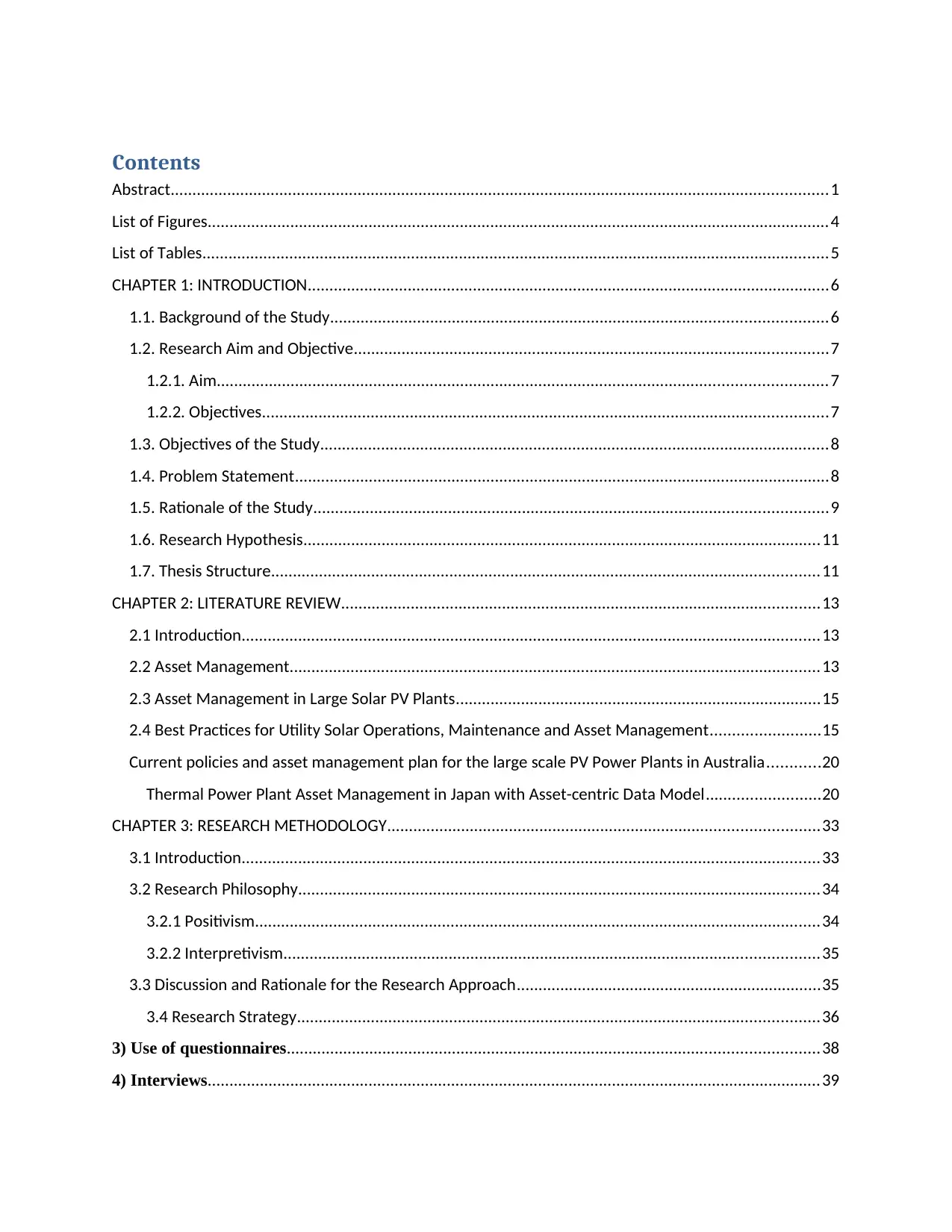
Contents
Abstract.......................................................................................................................................................1
List of Figures...............................................................................................................................................4
List of Tables................................................................................................................................................5
CHAPTER 1: INTRODUCTION........................................................................................................................6
1.1. Background of the Study..................................................................................................................6
1.2. Research Aim and Objective.............................................................................................................7
1.2.1. Aim............................................................................................................................................7
1.2.2. Objectives..................................................................................................................................7
1.3. Objectives of the Study.....................................................................................................................8
1.4. Problem Statement...........................................................................................................................8
1.5. Rationale of the Study......................................................................................................................9
1.6. Research Hypothesis.......................................................................................................................11
1.7. Thesis Structure..............................................................................................................................11
CHAPTER 2: LITERATURE REVIEW..............................................................................................................13
2.1 Introduction.....................................................................................................................................13
2.2 Asset Management..........................................................................................................................13
2.3 Asset Management in Large Solar PV Plants....................................................................................15
2.4 Best Practices for Utility Solar Operations, Maintenance and Asset Management.........................15
Current policies and asset management plan for the large scale PV Power Plants in Australia............20
Thermal Power Plant Asset Management in Japan with Asset-centric Data Model..........................20
CHAPTER 3: RESEARCH METHODOLOGY...................................................................................................33
3.1 Introduction.....................................................................................................................................33
3.2 Research Philosophy........................................................................................................................34
3.2.1 Positivism..................................................................................................................................34
3.2.2 Interpretivism...........................................................................................................................35
3.3 Discussion and Rationale for the Research Approach......................................................................35
3.4 Research Strategy........................................................................................................................36
3) Use of questionnaires..........................................................................................................................38
4) Interviews.............................................................................................................................................39
Abstract.......................................................................................................................................................1
List of Figures...............................................................................................................................................4
List of Tables................................................................................................................................................5
CHAPTER 1: INTRODUCTION........................................................................................................................6
1.1. Background of the Study..................................................................................................................6
1.2. Research Aim and Objective.............................................................................................................7
1.2.1. Aim............................................................................................................................................7
1.2.2. Objectives..................................................................................................................................7
1.3. Objectives of the Study.....................................................................................................................8
1.4. Problem Statement...........................................................................................................................8
1.5. Rationale of the Study......................................................................................................................9
1.6. Research Hypothesis.......................................................................................................................11
1.7. Thesis Structure..............................................................................................................................11
CHAPTER 2: LITERATURE REVIEW..............................................................................................................13
2.1 Introduction.....................................................................................................................................13
2.2 Asset Management..........................................................................................................................13
2.3 Asset Management in Large Solar PV Plants....................................................................................15
2.4 Best Practices for Utility Solar Operations, Maintenance and Asset Management.........................15
Current policies and asset management plan for the large scale PV Power Plants in Australia............20
Thermal Power Plant Asset Management in Japan with Asset-centric Data Model..........................20
CHAPTER 3: RESEARCH METHODOLOGY...................................................................................................33
3.1 Introduction.....................................................................................................................................33
3.2 Research Philosophy........................................................................................................................34
3.2.1 Positivism..................................................................................................................................34
3.2.2 Interpretivism...........................................................................................................................35
3.3 Discussion and Rationale for the Research Approach......................................................................35
3.4 Research Strategy........................................................................................................................36
3) Use of questionnaires..........................................................................................................................38
4) Interviews.............................................................................................................................................39
⊘ This is a preview!⊘
Do you want full access?
Subscribe today to unlock all pages.

Trusted by 1+ million students worldwide
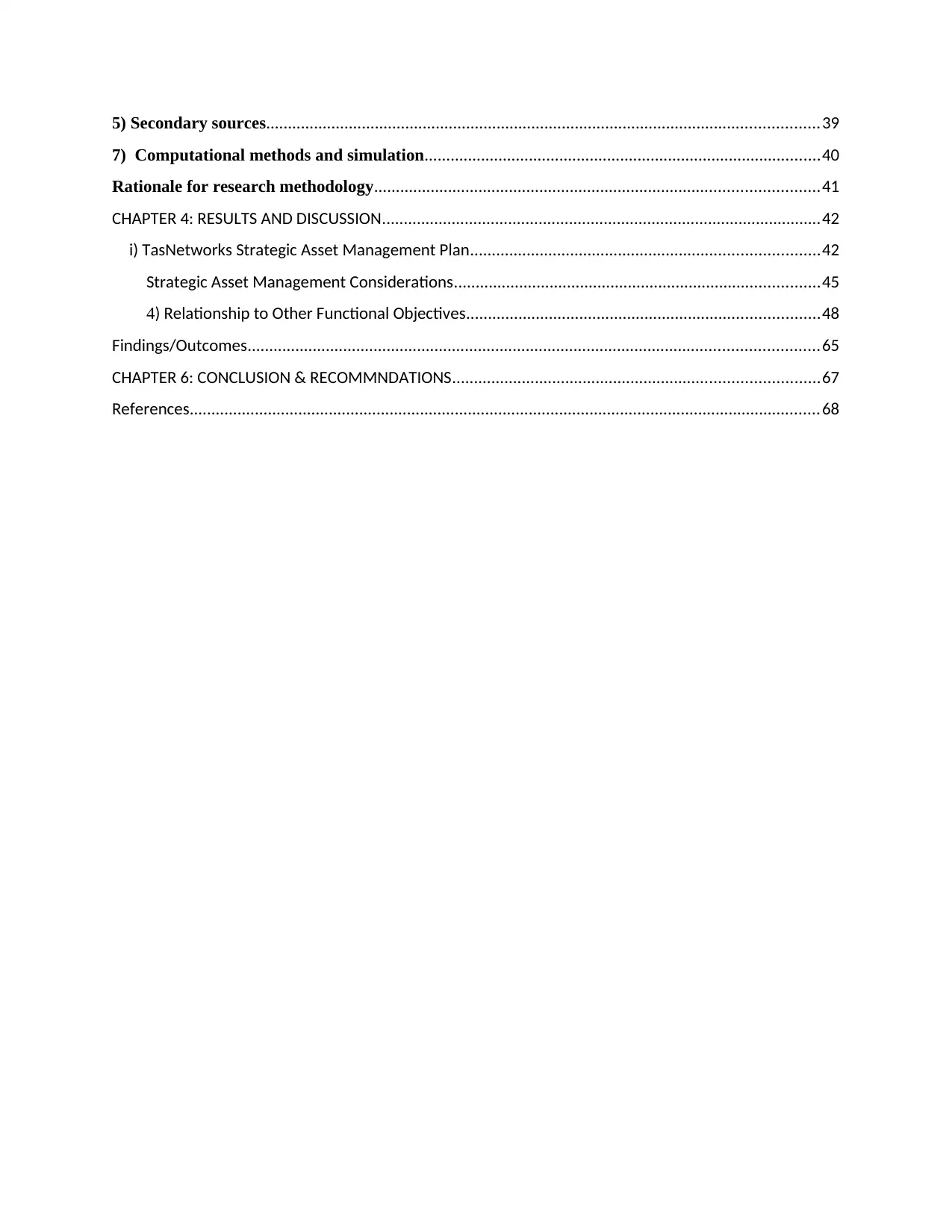
5) Secondary sources...............................................................................................................................39
7) Computational methods and simulation...........................................................................................40
Rationale for research methodology......................................................................................................41
CHAPTER 4: RESULTS AND DISCUSSION.....................................................................................................42
i) TasNetworks Strategic Asset Management Plan................................................................................42
Strategic Asset Management Considerations....................................................................................45
4) Relationship to Other Functional Objectives.................................................................................48
Findings/Outcomes...................................................................................................................................65
CHAPTER 6: CONCLUSION & RECOMMNDATIONS....................................................................................67
References.................................................................................................................................................68
7) Computational methods and simulation...........................................................................................40
Rationale for research methodology......................................................................................................41
CHAPTER 4: RESULTS AND DISCUSSION.....................................................................................................42
i) TasNetworks Strategic Asset Management Plan................................................................................42
Strategic Asset Management Considerations....................................................................................45
4) Relationship to Other Functional Objectives.................................................................................48
Findings/Outcomes...................................................................................................................................65
CHAPTER 6: CONCLUSION & RECOMMNDATIONS....................................................................................67
References.................................................................................................................................................68
Paraphrase This Document
Need a fresh take? Get an instant paraphrase of this document with our AI Paraphraser
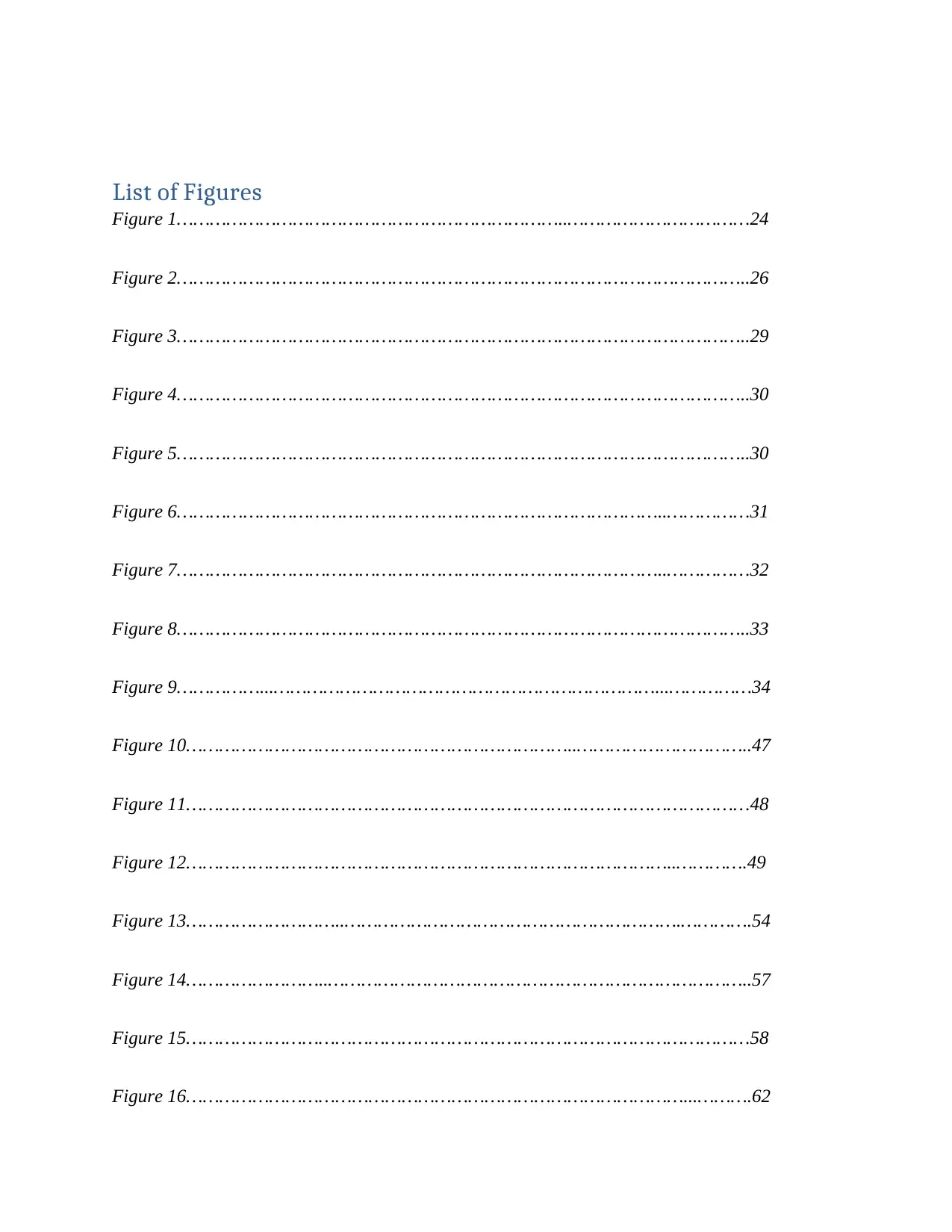
List of Figures
Figure 1……………………………………………………………..……………………………24
Figure 2…………………………………………………………………………………………..26
Figure 3…………………………………………………………………………………………..29
Figure 4…………………………………………………………………………………………..30
Figure 5…………………………………………………………………………………………..30
Figure 6……………………………………………………………………………..……………31
Figure 7……………………………………………………………………………..……………32
Figure 8…………………………………………………………………………………………..33
Figure 9……………...……………………………………………………………...……………34
Figure 10……………………………………………………………..…………………………..47
Figure 11…………………………………………………………………………………………48
Figure 12……………………………………………………………………………..………….49
Figure 13………………………..…………………………………………………….………….54
Figure 14……………………..…………………………………………………………………..57
Figure 15…………………………………………………………………………………………58
Figure 16………………………………………………………………………………...……….62
Figure 1……………………………………………………………..……………………………24
Figure 2…………………………………………………………………………………………..26
Figure 3…………………………………………………………………………………………..29
Figure 4…………………………………………………………………………………………..30
Figure 5…………………………………………………………………………………………..30
Figure 6……………………………………………………………………………..……………31
Figure 7……………………………………………………………………………..……………32
Figure 8…………………………………………………………………………………………..33
Figure 9……………...……………………………………………………………...……………34
Figure 10……………………………………………………………..…………………………..47
Figure 11…………………………………………………………………………………………48
Figure 12……………………………………………………………………………..………….49
Figure 13………………………..…………………………………………………….………….54
Figure 14……………………..…………………………………………………………………..57
Figure 15…………………………………………………………………………………………58
Figure 16………………………………………………………………………………...……….62
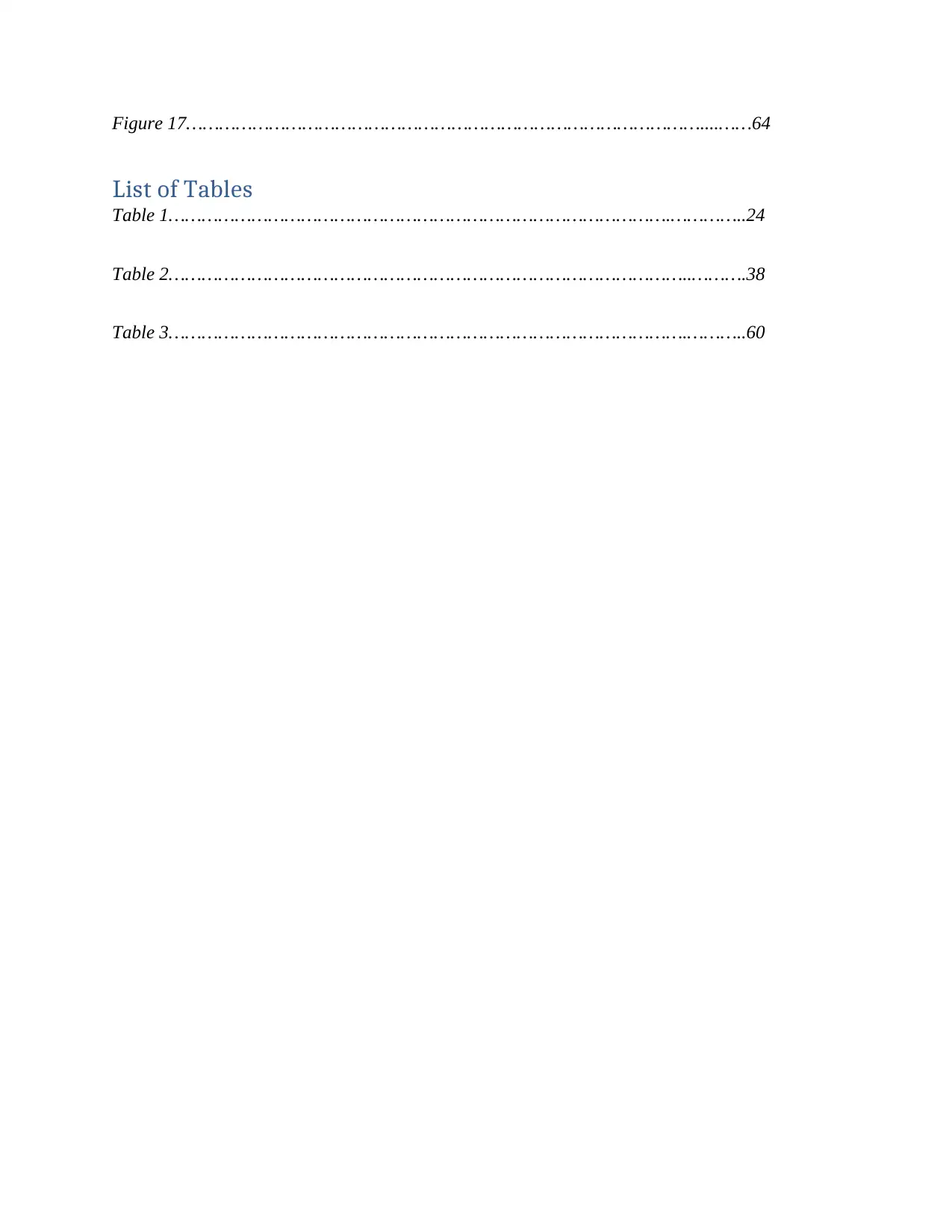
Figure 17…………………………………………………………………………………....……64
List of Tables
Table 1……………………………………………………………………………….…………..24
Table 2…………………………………………………………………………………..……….38
Table 3………………………………………………………………………………….………..60
List of Tables
Table 1……………………………………………………………………………….…………..24
Table 2…………………………………………………………………………………..……….38
Table 3………………………………………………………………………………….………..60
⊘ This is a preview!⊘
Do you want full access?
Subscribe today to unlock all pages.

Trusted by 1+ million students worldwide

CHAPTER 1: INTRODUCTION
1.1. Background of the Study
With the attention of the world shifting focus to global warming and climate change, alternative
sources of energy that are environmentally friendly and promoting sustainability have been
developed and continue to be developed. Australia is one os such countries that has not been left
behind either in such developments. There has been recorded an ever continuing upsurge in the
deployments of solar PV and such expansions are expected to even continue and surpass the
target in Australia (Abbasi, Islam & Shaikh 2014). More attention is thus being focused on the
maintenance and operations considerations more specifically for the case of utility scale plants
which dominate the market segment of the country. The arrangements of finances that govern
such melt-MW system mostly predicated on attaining the targets on the costs of productions
across 20 years and well as putting a premium on the performance of the lifecycles and
sustaining plant health.
However, the practices and protocols of operations and managements have remained quite a
distinct from attaining the standardization requirement and thus a high variation in the associated
budgeting in cases that are generally not sufficiently funded as per the number of stakeholders in
the industry (Adefarati & Bansal 2016).
The continued investigations and research on the strategies of lowering the plant capital
alongside the expenditures on the operation is, for one, exerting more and greater pressure on the
stakeholders of the project to align the operation and management practices and their associated
costs (Aghaei & Alizadeh 2013). Often perceived as a cost center on the balance sheet,
operations and management should it be even acknowledged as an input of value to the enduring
welfare of a PV plant often receives modest finding so as to meeting the threshold of the
1.1. Background of the Study
With the attention of the world shifting focus to global warming and climate change, alternative
sources of energy that are environmentally friendly and promoting sustainability have been
developed and continue to be developed. Australia is one os such countries that has not been left
behind either in such developments. There has been recorded an ever continuing upsurge in the
deployments of solar PV and such expansions are expected to even continue and surpass the
target in Australia (Abbasi, Islam & Shaikh 2014). More attention is thus being focused on the
maintenance and operations considerations more specifically for the case of utility scale plants
which dominate the market segment of the country. The arrangements of finances that govern
such melt-MW system mostly predicated on attaining the targets on the costs of productions
across 20 years and well as putting a premium on the performance of the lifecycles and
sustaining plant health.
However, the practices and protocols of operations and managements have remained quite a
distinct from attaining the standardization requirement and thus a high variation in the associated
budgeting in cases that are generally not sufficiently funded as per the number of stakeholders in
the industry (Adefarati & Bansal 2016).
The continued investigations and research on the strategies of lowering the plant capital
alongside the expenditures on the operation is, for one, exerting more and greater pressure on the
stakeholders of the project to align the operation and management practices and their associated
costs (Aghaei & Alizadeh 2013). Often perceived as a cost center on the balance sheet,
operations and management should it be even acknowledged as an input of value to the enduring
welfare of a PV plant often receives modest finding so as to meeting the threshold of the
Paraphrase This Document
Need a fresh take? Get an instant paraphrase of this document with our AI Paraphraser
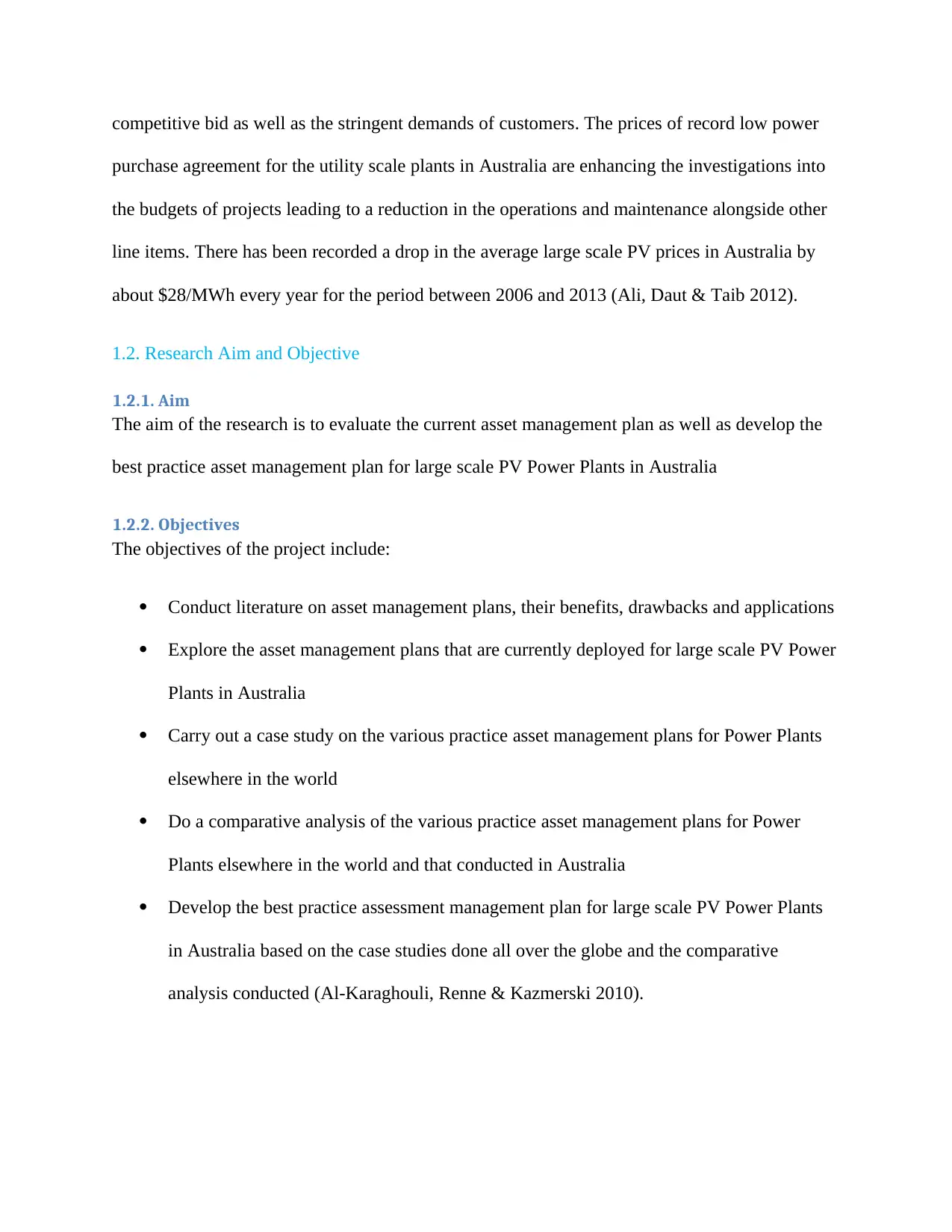
competitive bid as well as the stringent demands of customers. The prices of record low power
purchase agreement for the utility scale plants in Australia are enhancing the investigations into
the budgets of projects leading to a reduction in the operations and maintenance alongside other
line items. There has been recorded a drop in the average large scale PV prices in Australia by
about $28/MWh every year for the period between 2006 and 2013 (Ali, Daut & Taib 2012).
1.2. Research Aim and Objective
1.2.1. Aim
The aim of the research is to evaluate the current asset management plan as well as develop the
best practice asset management plan for large scale PV Power Plants in Australia
1.2.2. Objectives
The objectives of the project include:
Conduct literature on asset management plans, their benefits, drawbacks and applications
Explore the asset management plans that are currently deployed for large scale PV Power
Plants in Australia
Carry out a case study on the various practice asset management plans for Power Plants
elsewhere in the world
Do a comparative analysis of the various practice asset management plans for Power
Plants elsewhere in the world and that conducted in Australia
Develop the best practice assessment management plan for large scale PV Power Plants
in Australia based on the case studies done all over the globe and the comparative
analysis conducted (Al-Karaghouli, Renne & Kazmerski 2010).
purchase agreement for the utility scale plants in Australia are enhancing the investigations into
the budgets of projects leading to a reduction in the operations and maintenance alongside other
line items. There has been recorded a drop in the average large scale PV prices in Australia by
about $28/MWh every year for the period between 2006 and 2013 (Ali, Daut & Taib 2012).
1.2. Research Aim and Objective
1.2.1. Aim
The aim of the research is to evaluate the current asset management plan as well as develop the
best practice asset management plan for large scale PV Power Plants in Australia
1.2.2. Objectives
The objectives of the project include:
Conduct literature on asset management plans, their benefits, drawbacks and applications
Explore the asset management plans that are currently deployed for large scale PV Power
Plants in Australia
Carry out a case study on the various practice asset management plans for Power Plants
elsewhere in the world
Do a comparative analysis of the various practice asset management plans for Power
Plants elsewhere in the world and that conducted in Australia
Develop the best practice assessment management plan for large scale PV Power Plants
in Australia based on the case studies done all over the globe and the comparative
analysis conducted (Al-Karaghouli, Renne & Kazmerski 2010).
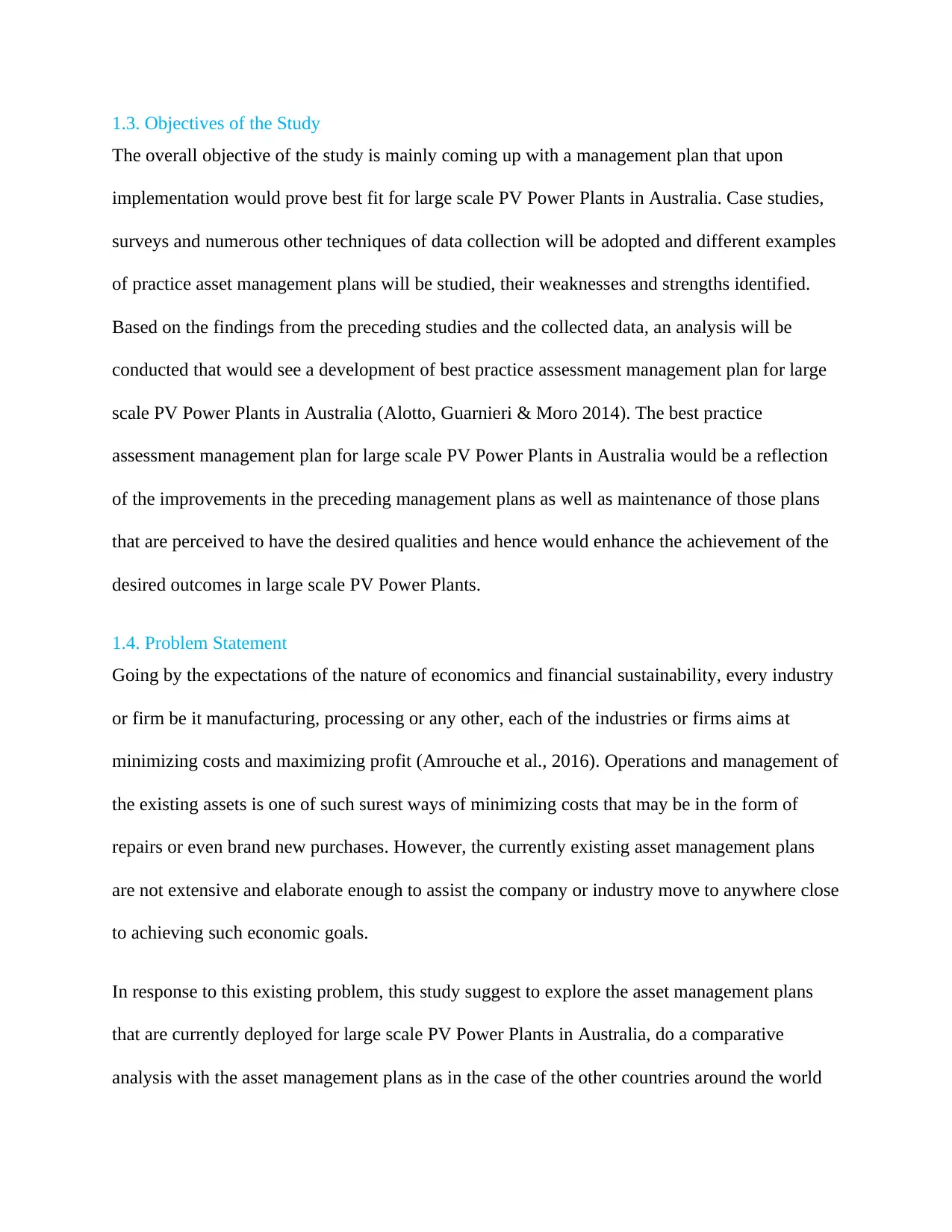
1.3. Objectives of the Study
The overall objective of the study is mainly coming up with a management plan that upon
implementation would prove best fit for large scale PV Power Plants in Australia. Case studies,
surveys and numerous other techniques of data collection will be adopted and different examples
of practice asset management plans will be studied, their weaknesses and strengths identified.
Based on the findings from the preceding studies and the collected data, an analysis will be
conducted that would see a development of best practice assessment management plan for large
scale PV Power Plants in Australia (Alotto, Guarnieri & Moro 2014). The best practice
assessment management plan for large scale PV Power Plants in Australia would be a reflection
of the improvements in the preceding management plans as well as maintenance of those plans
that are perceived to have the desired qualities and hence would enhance the achievement of the
desired outcomes in large scale PV Power Plants.
1.4. Problem Statement
Going by the expectations of the nature of economics and financial sustainability, every industry
or firm be it manufacturing, processing or any other, each of the industries or firms aims at
minimizing costs and maximizing profit (Amrouche et al., 2016). Operations and management of
the existing assets is one of such surest ways of minimizing costs that may be in the form of
repairs or even brand new purchases. However, the currently existing asset management plans
are not extensive and elaborate enough to assist the company or industry move to anywhere close
to achieving such economic goals.
In response to this existing problem, this study suggest to explore the asset management plans
that are currently deployed for large scale PV Power Plants in Australia, do a comparative
analysis with the asset management plans as in the case of the other countries around the world
The overall objective of the study is mainly coming up with a management plan that upon
implementation would prove best fit for large scale PV Power Plants in Australia. Case studies,
surveys and numerous other techniques of data collection will be adopted and different examples
of practice asset management plans will be studied, their weaknesses and strengths identified.
Based on the findings from the preceding studies and the collected data, an analysis will be
conducted that would see a development of best practice assessment management plan for large
scale PV Power Plants in Australia (Alotto, Guarnieri & Moro 2014). The best practice
assessment management plan for large scale PV Power Plants in Australia would be a reflection
of the improvements in the preceding management plans as well as maintenance of those plans
that are perceived to have the desired qualities and hence would enhance the achievement of the
desired outcomes in large scale PV Power Plants.
1.4. Problem Statement
Going by the expectations of the nature of economics and financial sustainability, every industry
or firm be it manufacturing, processing or any other, each of the industries or firms aims at
minimizing costs and maximizing profit (Amrouche et al., 2016). Operations and management of
the existing assets is one of such surest ways of minimizing costs that may be in the form of
repairs or even brand new purchases. However, the currently existing asset management plans
are not extensive and elaborate enough to assist the company or industry move to anywhere close
to achieving such economic goals.
In response to this existing problem, this study suggest to explore the asset management plans
that are currently deployed for large scale PV Power Plants in Australia, do a comparative
analysis with the asset management plans as in the case of the other countries around the world
⊘ This is a preview!⊘
Do you want full access?
Subscribe today to unlock all pages.

Trusted by 1+ million students worldwide
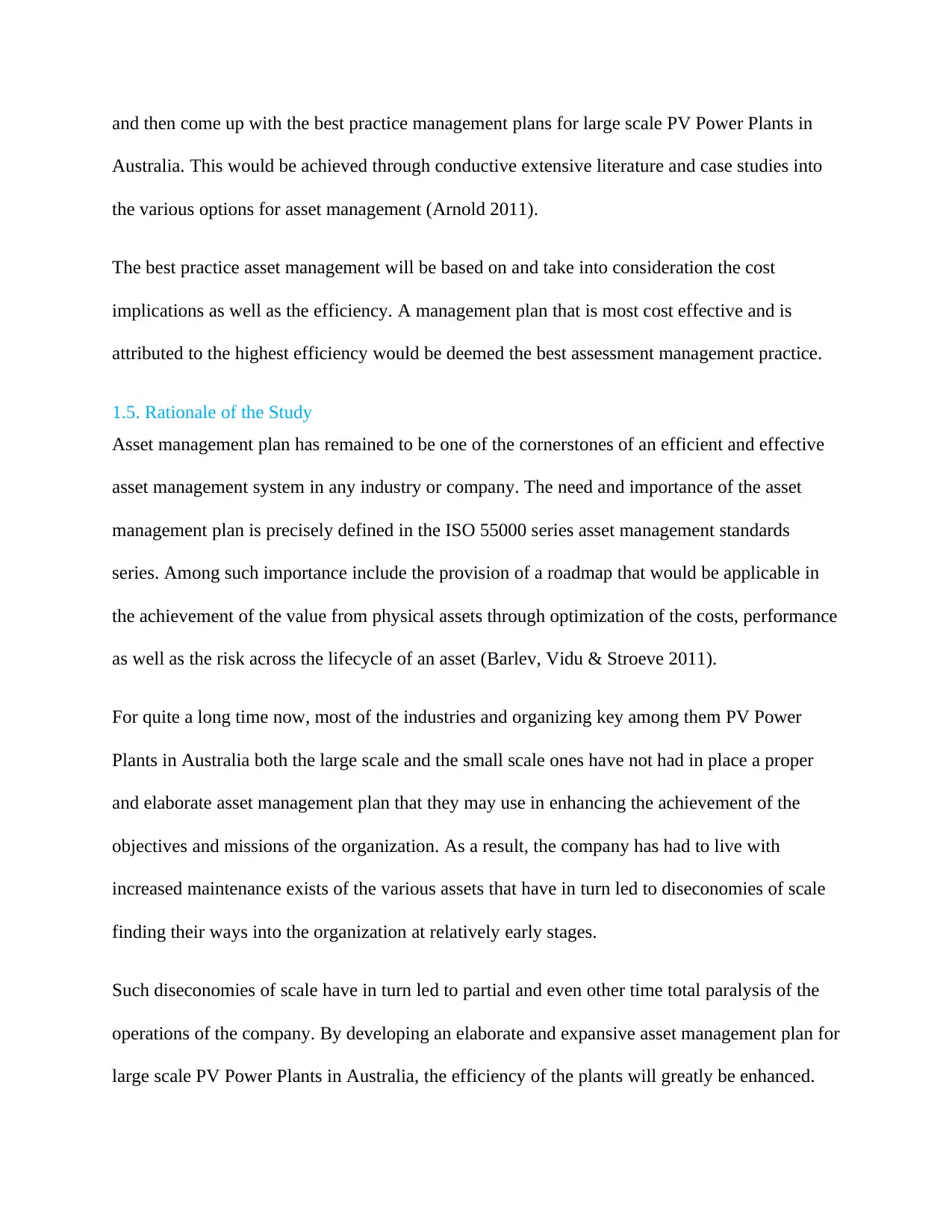
and then come up with the best practice management plans for large scale PV Power Plants in
Australia. This would be achieved through conductive extensive literature and case studies into
the various options for asset management (Arnold 2011).
The best practice asset management will be based on and take into consideration the cost
implications as well as the efficiency. A management plan that is most cost effective and is
attributed to the highest efficiency would be deemed the best assessment management practice.
1.5. Rationale of the Study
Asset management plan has remained to be one of the cornerstones of an efficient and effective
asset management system in any industry or company. The need and importance of the asset
management plan is precisely defined in the ISO 55000 series asset management standards
series. Among such importance include the provision of a roadmap that would be applicable in
the achievement of the value from physical assets through optimization of the costs, performance
as well as the risk across the lifecycle of an asset (Barlev, Vidu & Stroeve 2011).
For quite a long time now, most of the industries and organizing key among them PV Power
Plants in Australia both the large scale and the small scale ones have not had in place a proper
and elaborate asset management plan that they may use in enhancing the achievement of the
objectives and missions of the organization. As a result, the company has had to live with
increased maintenance exists of the various assets that have in turn led to diseconomies of scale
finding their ways into the organization at relatively early stages.
Such diseconomies of scale have in turn led to partial and even other time total paralysis of the
operations of the company. By developing an elaborate and expansive asset management plan for
large scale PV Power Plants in Australia, the efficiency of the plants will greatly be enhanced.
Australia. This would be achieved through conductive extensive literature and case studies into
the various options for asset management (Arnold 2011).
The best practice asset management will be based on and take into consideration the cost
implications as well as the efficiency. A management plan that is most cost effective and is
attributed to the highest efficiency would be deemed the best assessment management practice.
1.5. Rationale of the Study
Asset management plan has remained to be one of the cornerstones of an efficient and effective
asset management system in any industry or company. The need and importance of the asset
management plan is precisely defined in the ISO 55000 series asset management standards
series. Among such importance include the provision of a roadmap that would be applicable in
the achievement of the value from physical assets through optimization of the costs, performance
as well as the risk across the lifecycle of an asset (Barlev, Vidu & Stroeve 2011).
For quite a long time now, most of the industries and organizing key among them PV Power
Plants in Australia both the large scale and the small scale ones have not had in place a proper
and elaborate asset management plan that they may use in enhancing the achievement of the
objectives and missions of the organization. As a result, the company has had to live with
increased maintenance exists of the various assets that have in turn led to diseconomies of scale
finding their ways into the organization at relatively early stages.
Such diseconomies of scale have in turn led to partial and even other time total paralysis of the
operations of the company. By developing an elaborate and expansive asset management plan for
large scale PV Power Plants in Australia, the efficiency of the plants will greatly be enhanced.
Paraphrase This Document
Need a fresh take? Get an instant paraphrase of this document with our AI Paraphraser
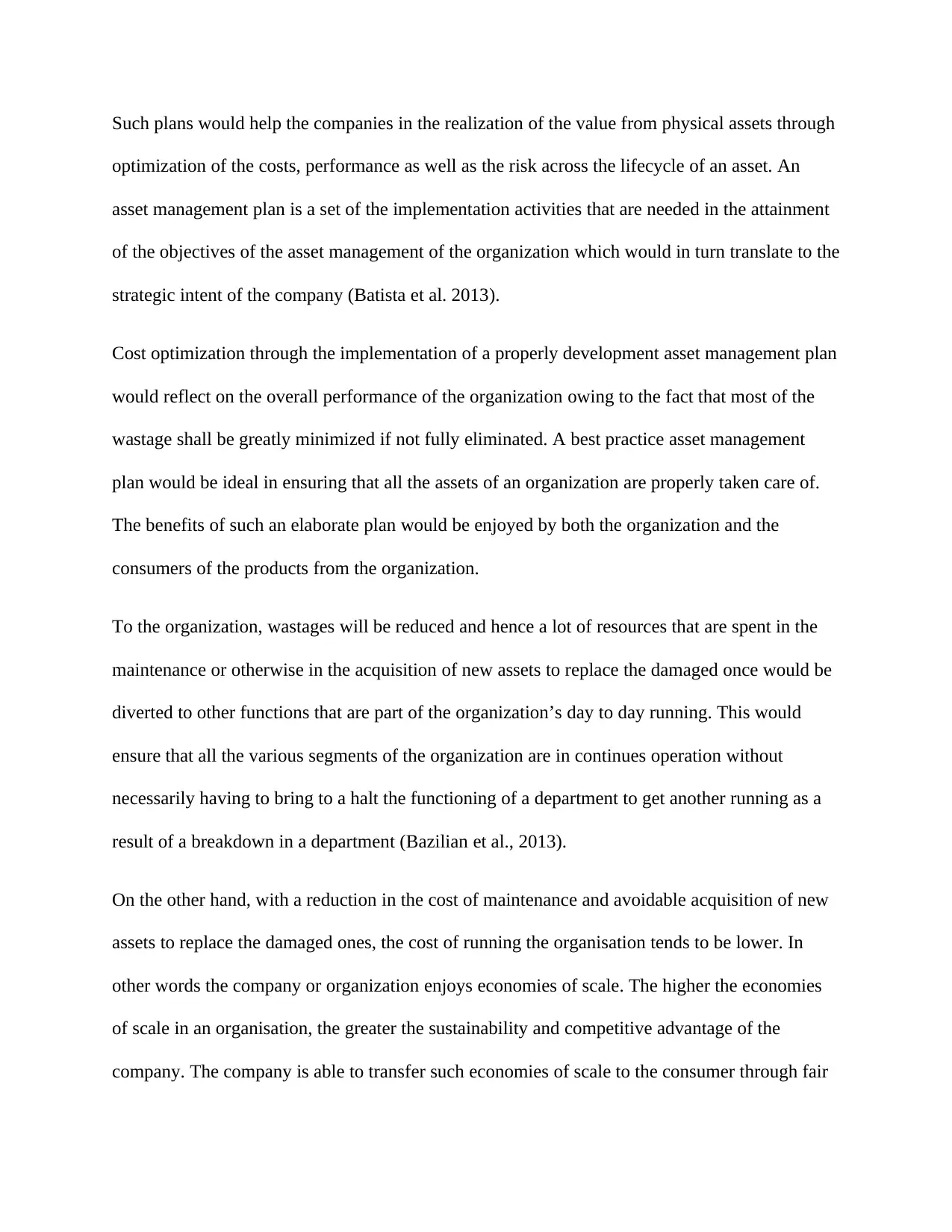
Such plans would help the companies in the realization of the value from physical assets through
optimization of the costs, performance as well as the risk across the lifecycle of an asset. An
asset management plan is a set of the implementation activities that are needed in the attainment
of the objectives of the asset management of the organization which would in turn translate to the
strategic intent of the company (Batista et al. 2013).
Cost optimization through the implementation of a properly development asset management plan
would reflect on the overall performance of the organization owing to the fact that most of the
wastage shall be greatly minimized if not fully eliminated. A best practice asset management
plan would be ideal in ensuring that all the assets of an organization are properly taken care of.
The benefits of such an elaborate plan would be enjoyed by both the organization and the
consumers of the products from the organization.
To the organization, wastages will be reduced and hence a lot of resources that are spent in the
maintenance or otherwise in the acquisition of new assets to replace the damaged once would be
diverted to other functions that are part of the organization’s day to day running. This would
ensure that all the various segments of the organization are in continues operation without
necessarily having to bring to a halt the functioning of a department to get another running as a
result of a breakdown in a department (Bazilian et al., 2013).
On the other hand, with a reduction in the cost of maintenance and avoidable acquisition of new
assets to replace the damaged ones, the cost of running the organisation tends to be lower. In
other words the company or organization enjoys economies of scale. The higher the economies
of scale in an organisation, the greater the sustainability and competitive advantage of the
company. The company is able to transfer such economies of scale to the consumer through fair
optimization of the costs, performance as well as the risk across the lifecycle of an asset. An
asset management plan is a set of the implementation activities that are needed in the attainment
of the objectives of the asset management of the organization which would in turn translate to the
strategic intent of the company (Batista et al. 2013).
Cost optimization through the implementation of a properly development asset management plan
would reflect on the overall performance of the organization owing to the fact that most of the
wastage shall be greatly minimized if not fully eliminated. A best practice asset management
plan would be ideal in ensuring that all the assets of an organization are properly taken care of.
The benefits of such an elaborate plan would be enjoyed by both the organization and the
consumers of the products from the organization.
To the organization, wastages will be reduced and hence a lot of resources that are spent in the
maintenance or otherwise in the acquisition of new assets to replace the damaged once would be
diverted to other functions that are part of the organization’s day to day running. This would
ensure that all the various segments of the organization are in continues operation without
necessarily having to bring to a halt the functioning of a department to get another running as a
result of a breakdown in a department (Bazilian et al., 2013).
On the other hand, with a reduction in the cost of maintenance and avoidable acquisition of new
assets to replace the damaged ones, the cost of running the organisation tends to be lower. In
other words the company or organization enjoys economies of scale. The higher the economies
of scale in an organisation, the greater the sustainability and competitive advantage of the
company. The company is able to transfer such economies of scale to the consumer through fair
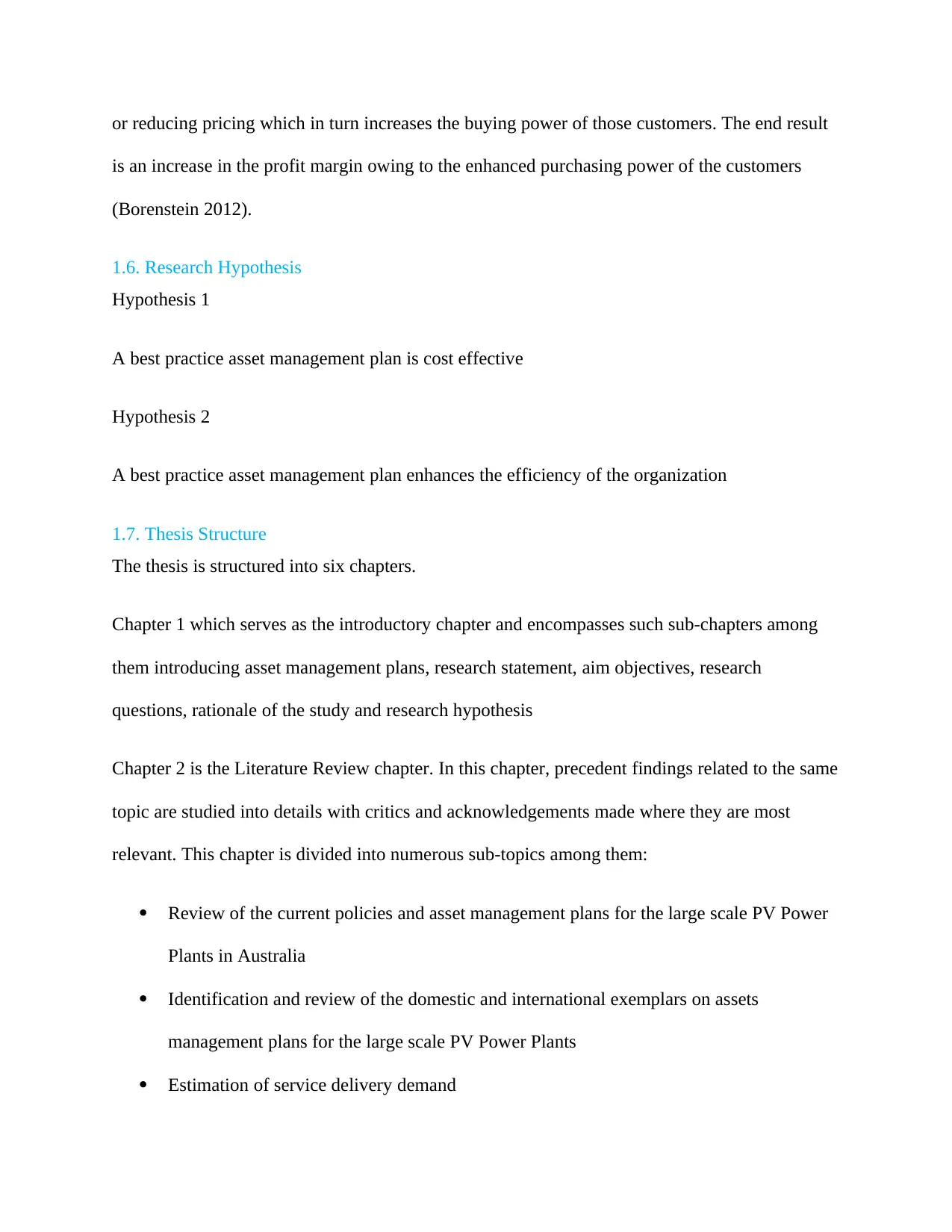
or reducing pricing which in turn increases the buying power of those customers. The end result
is an increase in the profit margin owing to the enhanced purchasing power of the customers
(Borenstein 2012).
1.6. Research Hypothesis
Hypothesis 1
A best practice asset management plan is cost effective
Hypothesis 2
A best practice asset management plan enhances the efficiency of the organization
1.7. Thesis Structure
The thesis is structured into six chapters.
Chapter 1 which serves as the introductory chapter and encompasses such sub-chapters among
them introducing asset management plans, research statement, aim objectives, research
questions, rationale of the study and research hypothesis
Chapter 2 is the Literature Review chapter. In this chapter, precedent findings related to the same
topic are studied into details with critics and acknowledgements made where they are most
relevant. This chapter is divided into numerous sub-topics among them:
Review of the current policies and asset management plans for the large scale PV Power
Plants in Australia
Identification and review of the domestic and international exemplars on assets
management plans for the large scale PV Power Plants
Estimation of service delivery demand
is an increase in the profit margin owing to the enhanced purchasing power of the customers
(Borenstein 2012).
1.6. Research Hypothesis
Hypothesis 1
A best practice asset management plan is cost effective
Hypothesis 2
A best practice asset management plan enhances the efficiency of the organization
1.7. Thesis Structure
The thesis is structured into six chapters.
Chapter 1 which serves as the introductory chapter and encompasses such sub-chapters among
them introducing asset management plans, research statement, aim objectives, research
questions, rationale of the study and research hypothesis
Chapter 2 is the Literature Review chapter. In this chapter, precedent findings related to the same
topic are studied into details with critics and acknowledgements made where they are most
relevant. This chapter is divided into numerous sub-topics among them:
Review of the current policies and asset management plans for the large scale PV Power
Plants in Australia
Identification and review of the domestic and international exemplars on assets
management plans for the large scale PV Power Plants
Estimation of service delivery demand
⊘ This is a preview!⊘
Do you want full access?
Subscribe today to unlock all pages.

Trusted by 1+ million students worldwide
1 out of 81
Related Documents
Your All-in-One AI-Powered Toolkit for Academic Success.
+13062052269
info@desklib.com
Available 24*7 on WhatsApp / Email
![[object Object]](/_next/static/media/star-bottom.7253800d.svg)
Unlock your academic potential
Copyright © 2020–2025 A2Z Services. All Rights Reserved. Developed and managed by ZUCOL.




